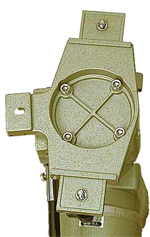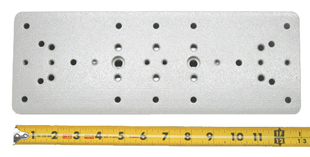Vixen Distribution
![]() History
History ![]() News
News ![]() Notes & Literature
Notes & Literature ![]() Overview
Overview ![]() Pricing
Pricing ![]() Products
Products
![]() Mounts
Mounts
![]() Telescopes
Telescopes
![]() Quality Control
Quality Control
![]() Service or Repair
Service or Repair


VIXEN MOUNT ATTACHMENT HARDWARE
![]() The Vixen Dovetail Plate System
The Vixen Dovetail Plate System
 An astronomical telescope is made up of two basic components including the optical tube, which determines what one may see, and the equatorial mount which determines how the telescope may be used. Getting these two items together has not always been easy, but quick release hardware sure makes it easier than ever before.
An astronomical telescope is made up of two basic components including the optical tube, which determines what one may see, and the equatorial mount which determines how the telescope may be used. Getting these two items together has not always been easy, but quick release hardware sure makes it easier than ever before.
Left: Rigid Saddle of the 1980's Vixen Super Polaris Series German Equatorial Mount.
Note two captive ¼ inch 20 tpi attachment bolts which secure the telescope mounting rings (not shown) in place.
This was arrangement was typical of most German Mounts into the early 1990's (28,098 bytes).
Click on image to see enlarged view (92,256 bytes)
Up until the late 1980's most telescopes were installed onto Mounting Rings which were usually bolted onto the mount Saddle - the flat area on top of the Declination axis of an German Equatorial mount. This took a little time and some luck particularly when trying to match up a hole pattern and installation bolts in the dark. This arrangement kept the spacing between two rings fixed, often a bit too close for some with longer, torque inducing telescopes. And if the Mount fell over, then the protruding Saddle tip could be broken off rendering the mount unusable until repaired.
By the end of the 1980's quick release hardware became more common. It was popularized by companies including Losmandy and Astro-Physics which Company Seven continues to offer. When Vixen discontinued their previous "Super Polaris" series mounts and announced the current "Great Polaris" (or GP) line, one of the notable improvements was the incorporation of quick release hardware. The quick release hardware includes two basic components:

- a male dovetail plate, a metal plate usually of two or four inches in width with lengths of between six to fourteen inches or more
- a female plate (or saddle) onto which the dovetail plate slides on lengthwise, or slips in sideways and settles flat. The saddle incorporates at least one, maybe two hand knobs which are tightened to secure the dovetail plate in place.
Right: Diagram of Vixen SPHINX SX and SXW German Equatorial Mount Hardware (38,221 bytes).
Click on image to see enlarged view (69,183 bytes)
The telescope mounting rings are now bolted onto the dovetail plate. On some plates, the mounting bolts protrude below the plate and act as safety stops to keep the telescope from sliding off the mount if the saddle is accidentally loosened. The advantages of the quick release hardware include:
- the Mount Head can then accept any accessory that is attached to a compatible dovetail plate,
- quick and simple changing of optical tube position, or easy removal of the OTA and installation of another in its place - all with out the need for any tools,
- some dovetail plates are so long so that an attached telescope may be moved forward or back on the saddle to better balance it along the Declination axis,
![]() Vixen Hardware and Specifications
Vixen Hardware and Specifications
 How To Set Up The Equatorial Mount Telescope. Pages 11 through 15 of the illustrated instruction manual provided with the Great Polaris GP and Great Polaris GPDX mounts. This explains the Polar Alignment of the these mounts, how to use the Vixen Pole Alignment Finderscope, and how to read and use the setting circles. Copyright Vixen Co., Ltd, from Company Seven's Library. Five pages. Download size is 2,917,348 bytes (in Acrobat Reader ".pdf" format).
How To Set Up The Equatorial Mount Telescope. Pages 11 through 15 of the illustrated instruction manual provided with the Great Polaris GP and Great Polaris GPDX mounts. This explains the Polar Alignment of the these mounts, how to use the Vixen Pole Alignment Finderscope, and how to read and use the setting circles. Copyright Vixen Co., Ltd, from Company Seven's Library. Five pages. Download size is 2,917,348 bytes (in Acrobat Reader ".pdf" format).
 Time Zone and Meridian Offset Reference Information. The information here will assist in setup of the Vixen Polar Axis Scope (GP and SX models), many third party Pole Finders, the SkySensor 2000 and STAR BOOK controllers. Copyright Vixen North America, from Company Seven's Library. Two pages. Download size is 31,714 bytes (in Acrobat Reader ".pdf" format).
Time Zone and Meridian Offset Reference Information. The information here will assist in setup of the Vixen Polar Axis Scope (GP and SX models), many third party Pole Finders, the SkySensor 2000 and STAR BOOK controllers. Copyright Vixen North America, from Company Seven's Library. Two pages. Download size is 31,714 bytes (in Acrobat Reader ".pdf" format).
 GP Series Male Dovetail Plate
GP Series Male Dovetail Plate
Slips onto Vixen GP series mounts. Used to attach telescope with Vixen Tube Rings or third party Rings with ¼-20 tpi threaded holes. Or other devices may be attached including a camera. These Dovetail Plates described as being for GP or SX are interchangeable. Provided with two ¼"-20 tpi bolts. The GP or SX designation refers only to the differences in finish, these being green or pearl white to complement the mounts.
-
Length: 7.5 inches / 190 mm
Maximum Width: 1.7 inches / 43 mm
Holes: all drilled smooth for ¼ inch bolts
Spacing of outer two holes: 6.3 inches / 160 mm
Spacing of inner two holes: 1.4 inch / 35 mm
Weight: 5.8 oz / 164 grams
Model # AM-AD-3809
Right: GP Series Male Dovetail Plate (31,621 bytes).
Click on image to see enlarged view (42,522 bytes)
Left: similar SX Series Male Dovetail Plate P/N 2661 viewed from below, milled to reduce weight improve rigidity (35,070 bytes).
Click on image to see enlarged view (35,070 bytes)
Slips onto Vixen GP series mounts. Used to attach telescope with Vixen Tube Rings or third party Rings with ¼-20 tpi threaded holes. Or other devices may be attached including a camera. These Dovetail Plates described as being for GP or SX are interchangeable. Provided with two ¼"-20 tpi bolts. The GP or SX designation refers only to the differences in finish, these being green or pearl white to complement the mounts.
Above Right: GP Series Male Dovetail Plate from above (16,550 bytes).
This heavy-duty plate contains a variety of smooth and some threaded holes for mounting telescopes and other accessories onto Vixen equatorial mounts equipped with a Dovetail Saddle. The plate is provided with a slide bar attached beneath it so that it slides onto the top of the Mount Head to facilitate quick changes of payload. A safety stop bolt is installed near each end of the Dovetail Plate, these are separated by a span of 5.9 inches / 150.7 mm.
Right: SX Large Accessory Flat Plate bottom view (43,170 bytes).
Vixen tube and accessory rings, fine adjustment units, guide scopes and other 1/4 and 3/8 inch bolt-on accessories can be attached. The large accessory plate makes an excellent platform for mounting two telescopes side-by-side for imaging and guiding, or for optical comparison. Great for custom mounting home built and other non-Vixen tubes to Vixen equatorial mounts. The plate is provided with an assortment of 1/4"-20 tpi bolts and wrenches.
Right: SX Large Accessory Flat Plate top view (45,758 bytes).
This heavy-duty plate contains a variety of slots, and smooth and some threaded holes for mounting telescopes and accessories to Vixen equatorial mounts. The plate is provided with a slide bar attached beneath it (barely visible in the image shown here) so that it slides onto the top of the SX series Mount Head to facilitate quick changes of payload.
Vixen tube and accessory rings, fine adjustment units, guide scopes and other 1/4 inch bolt-on accessories can be attached. The large accessory plate makes an excellent platform for mounting two telescopes side-by-side for imaging and guiding, or for optical comparison. Great for custom mounting home built and other non-Vixen tubes to Vixen equatorial mounts. The plate is provided with an assortment of 1/4"-20 tpi bolts and wing nuts. GP and SX versions only differ by color.
Dovetail: included
Right: GP Series Male Dovetail Plate (31,621 bytes).
Similar to image of SX Large Plate above, but in GP Green finish. Also discontinued.
GP Large Accessory Flat Plate
This heavy-duty plate contains a variety of slots and smooth and threaded holes for mounting telescopes and accessories to Vixen equatorial mounts. The plate comes with GP-compatible dovetail rail on the bottom to facilitate quick changes of payload.
Vixen tube and accessory rings, fine adjustment units, guide scopes and other ¼ inch bolt-on accessories can be attached. The large accessory plate makes an excellent platform for mounting two telescopes side-by-side for imaging and guiding, or for optical comparison. Great for custom mounting home built and other non-Vixen tubes to Vixen equatorial mounts. The plate is provided with an assortment of ¼ 20 tpi bolts and wing nuts. The GP and SX versions of this plate only differ by color.
Right: GP Series Male Dovetail Plate (31,621 bytes).
A flat plate with attachment points for installing this plate on top of a telescope spanning a pair of tube rings. Accessories such as a camera or guide scope can then be attached onto the plate. Most of the area between the outer two mounting holes is covered with a textured, non-slip rubber covering.
Dimensions: 7.5 x 2 inch / 190 x 50 mm
Right: GP Series Male Dovetail Plate (31,621 bytes).
Specifications and availability subject to change
Please visit Company Seven's showroom to see examples of these Vixen systems firsthand. Or you may Contact Company Seven for help putting together a system for you.
 SX Series Male Dovetail Plate
SX Series Male Dovetail Plate
Length: 7.5 inches / 190 mm
Maximum Width: 1.7 inches / 43 mm
Holes: all drilled smooth for ¼ inch bolts
Spacing of outer two holes: 6.3 inches / 160 mm
Spacing of inner two holes: 1.4 inch / 35 mm
Weight: 5.4 oz / 160 grams (without bolts)
Model # AM-AD-2661
Click on image to see enlarged view (44,849 bytes)
Click on image to see enlarged view (35,070 bytes)
 SX Large Accessory Flat Plate
SX Large Accessory Flat Plate
Click on image to see enlarged view (112,853bytes)
 Attached Dovetail Plate: 6-9/16 inch / 165.9 mm long
Attached Dovetail Plate: 6-9/16 inch / 165.9 mm long
Weight: 43.6 oz / 1238 grams
Overall Length: 7-1/2 inches
Width: 0.54 inches / 120.2 mm
Thickness of main plate: 4.73 inches / 13.6 mm
Spacing of outer two holes: 6.3 inches / 160 mm
Model # AM-AD-2575
Click on image to see enlarged view (135,725 bytes)
 SX Large Accessory Flat Plate
SX Large Accessory Flat Plate
Discontinued and replaced by Plate P/N 2576 above, posted for information purposes only.
Weight: 12.3 oz / 350 grams
Overall Length: 7-1/2 inches
Spacing of outer two holes: 6.3 inches / 160 mm
Model # AM-AD-2575
Click on image to see enlarged view (42,522 bytes)
Dovetail: included
Weight: 24.7 oz / 700 grams
Overall Length: 7-1/2 inches
Spacing of outer two holes: 6.3 inches / 160 mm
Model # AM-AD-3808
Click on image to see enlarged view (42,522 bytes)
 Tube Ring Accessory Plate
Tube Ring Accessory Plate
Weight: 9.7 oz / 276 grams
Model # AM-AD-3548
Click on image to see enlarged view (42,522 bytes)
Further Reading
Refer to our Library for the articles:
Contents Copyright 1994-2006 Company Seven All Rights Reserved


